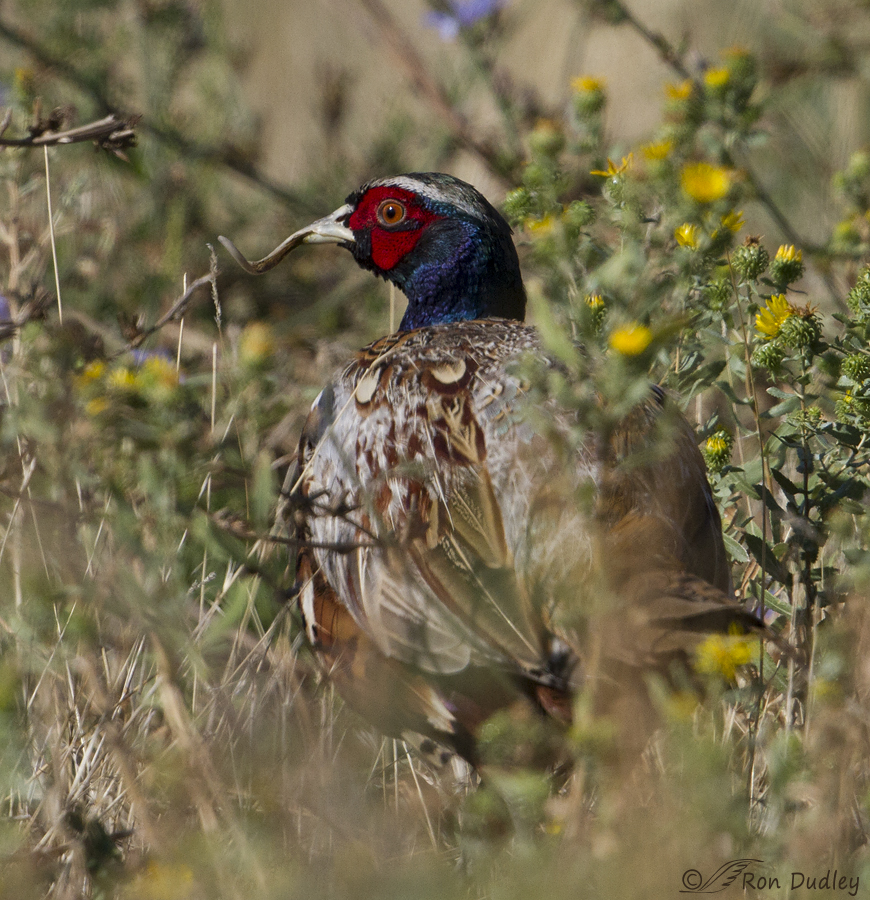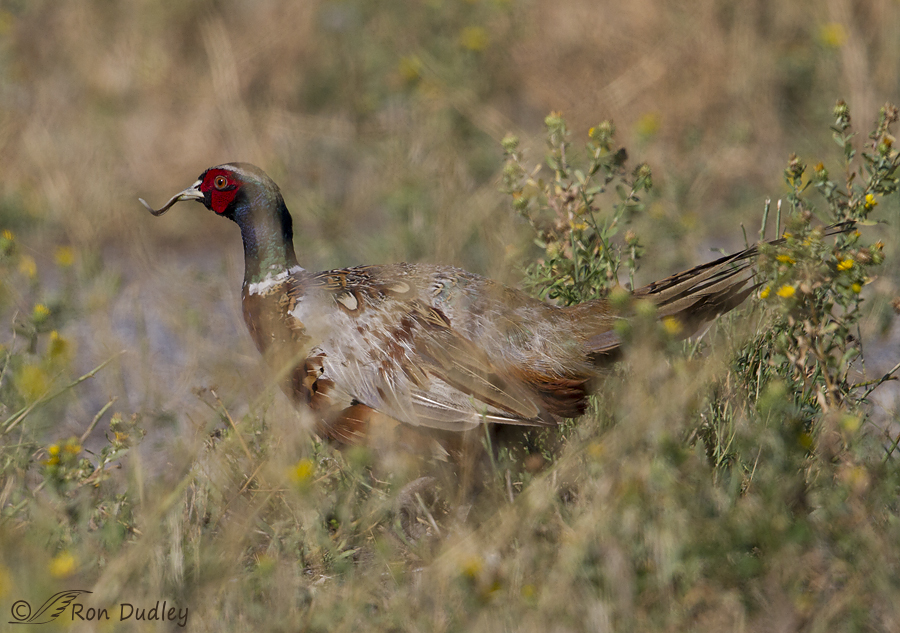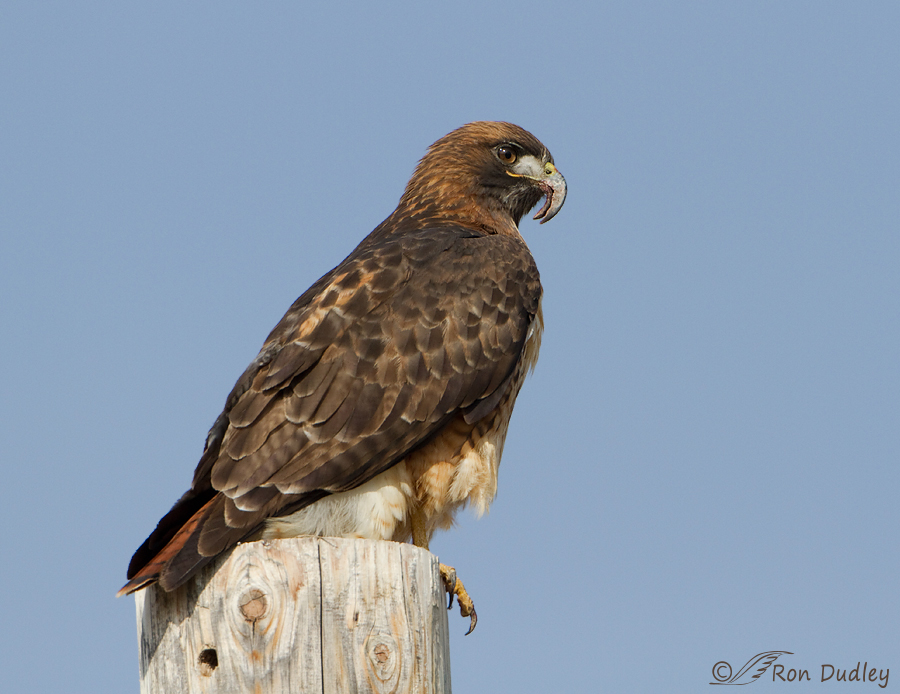Over the years I’ve documented a variety of birds with severely deformed beaks, including the two examples below.

I photographed this adult male Ring-necked Pheasant at Farmington Bay WMA in August of 2014. Its maxilla is grossly deformed into an abnormally long twisting curve that begins to resemble a corkscrew shape.

Another photo of the same bird.

This adult Red-tailed Hawk hung around the same area near Grantsville, Utah for several weeks in the fall and early winter of 2011. Both the mandible and the maxilla are extremely long and deformed. Despite its handicap I watched as this bird caught and consumed several voles so it was still able to hunt and eat but it had to be at a huge disadvantage.
I’ve also seen and/or photographed several other species with abnormal bills, including Red-winged Blackbirds and Sage Thrashers. The disorder is known to occur in at least 24 species of North American birds.
In the past I’ve published blog posts about these unusual birds and made some inquiries and at the time very little was known about the condition and its cause was unknown but several scientists and institutions were investigating. Since many of the first birds seen with beaks like these were Red-tailed Hawks the condition was tentatively called “long-billed hawk syndrome” even though species other than raptors were involved.
But now we may know the cause of the disease, now called “avian keratin disorder”. Earlier this week it was reported that strong evidence suggests the culprit is a previously unknown virus – Poecivirus. Using advanced DNA and RNA sequencing technologies the virus was found in every diseased bird that was tested. I won’t bore readers with more details but an article on the latest findings can be found here.
Finding a cause is far from finding a prevention or a cure but it’s a step in the right direction and that gives me at least some small amount of comfort and hope.
Ron
PS – Yesterday I sent links to my photos of the Red-tailed Hawk and Ring-necked Pheasant with deformed bills to Dr. Russell Norvell, Avian Conservation Program Coordinator at Utah Division of Wildlife Resources and asked him if those two birds look like they’re affected by avian keratin disorder. I include his response below:
- “These look consistent with the disease. So that’s several more species for the Utah list unfortunately.”


Very interesting Ron. Learned something new again from you. Thank you. Your images are very sharp of these diseased birds. I am sure the research literature would value them. I am glad to hear that you saw the birds eating in what sounds like a “normal enough” manner. Survivors ( I hope…) !
Thanks for this information. The article did not list all the species that have been documented with the virus. It does not sound like the isolated RNA virus is the proven causative agent at this time.
Since the pheasant is in the chicken family, chickens could be used as test subjects and inoculated with the virus to determine if it causes the same reaction in chickens. If it affect chickens, sources of money for a preventative might be available.
Comparing the diets of birds documented with the malady and those without it might point out some plant that protects keratin against the virus, such as elderberry protects humans against flu and some cold viruses.
Oh, those poor birds! I’m actually sort of surprised that they made it to adulthood, especially the pheasant. I’m also sorry to learn that the affected species list seems to be so high. I wonder what the mode of infection is or if there’s a particular vector or vectors. Please keep us updated.
Marty, these birds likely didn’t have the condition as very young birds but developed it later instead. So far they haven’t found the deformed beak in any birds younger than 6 months.
I’ve been fostering dogs/puppies and cats/kittens for so long, I keep forgetting that so many animals mature so much faster! Whoops!
I am so glad that a start has been made.
We see a similar disorder here. Psittacine circoviral disease known as beak and feather disease. It is often fatal because the birds can neither eat or groom. A long and unpleasant death. I have caught and taken birds to a local clinic to give them a quicker end. And mourned.
EC, This condition causes some of the same problems – eating and grooming difficulties. And with our winter weather in particular, birds whose feathers aren’t well taken care of often succumb.
Thanks for the information.
You’re welcome, Linda.
I’m glad that someone has figured out the cause of the problem. The thing I wonder about is how could wild birds be treated, or how could a vaccine or some other preventative be distributed among widely diverse and widespread populations. Hopefully someone has ideas on how to do that. Looking at the Pheasant photos, I find it amazing that a bird with a beak like that could survive at all.
Birds can get creative (up to a point) in their efforts to adapt to something like this, Susan. I watched the red-tail eating several voles and its eating technique was noticeably different from that of healthy hawks.
They look about like a toenail with fungus, I wonder if ducks get that problem with their bills.
“I wonder if ducks get that problem with their bills”
Marvin, If they do I’ve never seen or heard of it.
Extremely interesting, Ron. Thank you for your endless curiosity and research!
Thanks, Deborah.
Interesting but AWFUL!!!!
Yup, on both counts.
Very interesting! That’s the first step in finding a cure. Definite progress.
Charlotte
Charlotte, even if no cure is found it’s possible that methods of controlling its spread might be. Thanks.
I have seen weird beaks before, but nothing like what you photographed.
Very interesting stuff Ron, many thanks for bringing this to our attention.
Thank you, Dick.
Glad they have a clue as to the cause now even if no prevention/cure. It is a definite handicap for the birds. I wonder how many don’t adapt and perish from it……………. I’m sure your photo’s and others help the scientists with this.
Judy, from what I’ve found out from my inquiries I think the disease is usually eventually lethal because they can’t feed or preen normally.